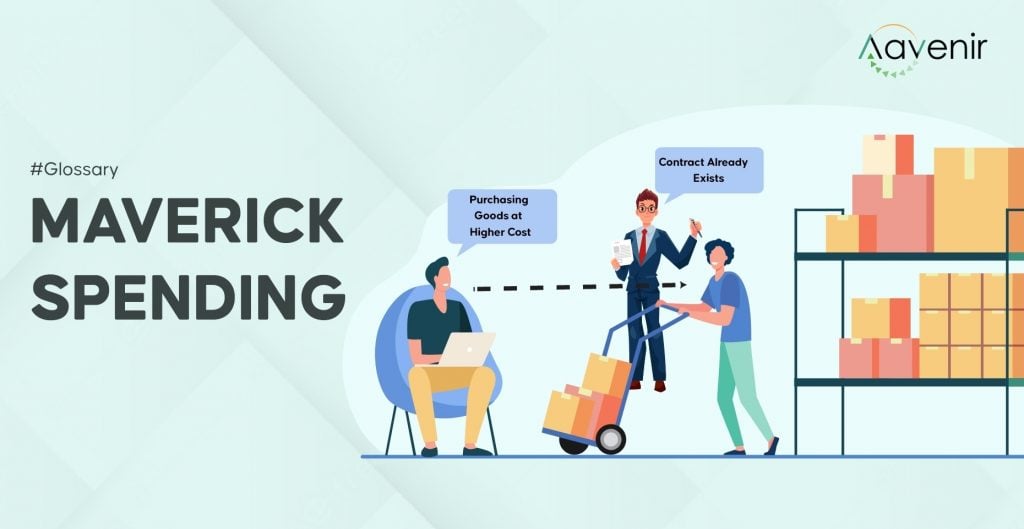What is Maverick Spending?

Purchasing from vendors outside of established procurement policies is known as maverick spending. Off-contract spending or purchasing from non-preferred vendors are examples of maverick spending.
Maverick spending accounts for anything from 25% to 80% of overall spending across all enterprises. It means you won’t be able to take advantage of the deals and discounts you worked so hard to secure. Maverick spending is nonetheless a tiny leakage from negotiated supplier contracts at best and unregulated, rebellious purchasing at worst.
How is Maverick Spending a Problem
The primary issues with maverick spending are the loss of agreed contract savings and the danger of contract breach due to volume leakage. With the number one priority in procurement being cost reduction, maverick expenditure entails losing cost savings by not utilizing pre-negotiated rates or capturing discounts by failing to meet volume targets.
Purchasing from unauthorized or uncontracted suppliers exposes the company to operational, supply, and reputational risk. It may also cause issues with crucial supplier relationships and source-to-pay operations.
According to research by the Chartered Institute of Procurement & Supply (CIPS), maverick buying accounts for up to 80% of all invoices in many firms, including large organizations with procurement teams. Maverick purchasing is essentially unregulated spending, which leads to poor contract compliance and benefits realization.
Moreover, there are long-term consequences of maverick spending, such as the loss of savings that you can realize through negotiated contracts. Furthermore, maverick spending increases the danger of a potential breach of contract with suppliers and time wasted by accounting staff attempting to reconcile accounting.
What Leads to Maverick Spending in Organizations?
Most employees do not spend unconventionally or with rebellious intent. However, much of the difficulty with unregulated spending stems from long-standing habits, especially if off-contract spending is not monitored. The primary reason for maverick spending is insufficient tools and processes and a lack of information and communication.
Ineffective & time-consuming procurement processes
Inefficient operations may result in maverick spending. When the P2P method is not well defined or explained, users, i.e., corporate shoppers, experience both confusion and frustration. An inadequately performing P2P procedure causes a corporate shopper to seek a more straightforward and faster solution to meet their demands.
Employees may find corporate purchasing procedures difficult and time-consuming compared to consumer purchasing. Purchase Requisitions (PR) and Purchase Orders (PO) that are approved slowly seem to be responsible. Employees will break the rules if purchase processes are inadequate – reducing profitability and exposing your organization to operational risks.
Poor internal communication
Studies reveal that [poor communication frequently leads to Maverick Spending. Employees may be unaware of preferred vendors or procurement policies. Contract implementation is often poorly executed and informed late, if at all. Employees can only benefit from contracts if they are aware of their existence.
For example, they may be unaware of the complete details of the agreement, potential savings, and value-added services that affect the total cost of ownership (TCO). Often, the terms and conditions of a well-negotiated contract are unclear, or there is limited access to the contract’s contents, making users tempted to find their own supplier instead.
Employees will choose a more accessible route under challenging categories such as marketing, maintenance & repair, IT software, and some professional services. This is common in decentralized companies or those that operate in silos.
How do you Tackle Maverick Spending?
We can see from the points above that a forward-thinking organization does not gain from maverick spending. Instead, maverick spending eats into profitability and puts your company in danger of operational failure.
So, to reduce risks, stabilize your day-to-day business operations, and increase profitability, you must take immediate action against maverick spending. Here are four ways you can reduce your maverick spending.
1. Conduct a detailed spend analysis
Before attempting to cut your maverick spending, you must first develop a precise summary of how much you spend outside existing contracts. To accomplish this, you must break down your spending to the fundamentals to determine where your money is going.
Then, identify the suppliers and stakeholders on your team who are the primary drivers of maverick spending. After that, assess the immediate and long-term expenses — for example, how much maverick spending costs vs. how much you would have spent if you followed contracts.
2. Educate your team
Before you can get your team to participate in the procurement process, they need to know where procurement fits into the big picture. Everyone on your team must understand that:
- centralized procurement saves you money on purchases;
- maverick expenses directly affect your company’s bottom line;
- supplies obtained from unauthorized suppliers may be harmful to your internal operations
- centralized procurement can function if everyone does their part to make it work properly.
3. Adopt smarter procurement systems and processes
Your procurement process is only as good as the tools and methods you have at your disposal. To increase your chances of eliminating maverick spending, you should:
- Provide your procurement team with strategic tools that streamline the process and make it easy for the rest of the organization to collaborate with the procurement team
- Encourage team members to identify pain points in your current procurement process
- Build simpler processes so teams and individuals can easily make requests
- Implement a purchase approval process so purchases can be vetted by procurement before being made. This allows procurement teams to spot purchases covered by current contracts and take full advantage of them.
Your systems and processes are the foundation of your attempts to eliminate maverick spending. Therefore it’s vital to keep them up to date and running at full performance.
4. Create a process for special purchase needs
No matter how carefully your procurement systems and processes are structured, there will always be a few occasions when you must be ready to supply a requirement without a current vendor to cover it. Perhaps there is an urgent need that your current vendor cannot meet within a reasonable time frame.
It’s best to develop a basic escalation process that outlines the steps to be taken when existing vendors cannot reasonably fulfill the desired supply to avoid such scenarios resulting in unregulated maverick spending.
Over to you
So, it is clear that maverick expenditure occurs mostly when an organization employs complex or severely limited technologies that complicate the procurement for stakeholders and cause them to seek alternatives. On the other hand, a procurement solution like Aavenir RFPflow simplifies the sourcing process so stakeholders can easily collaborate.



